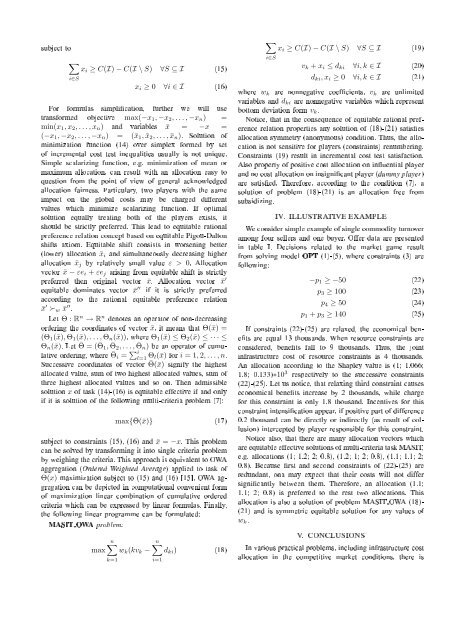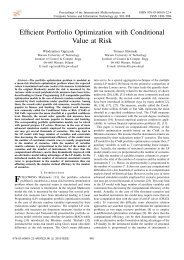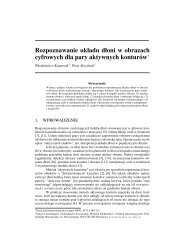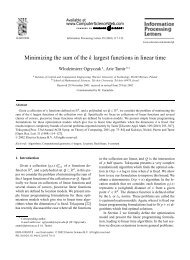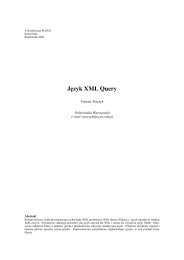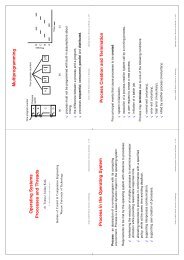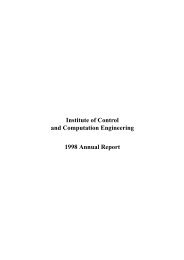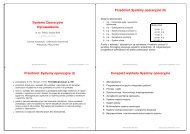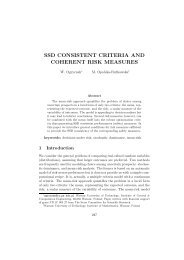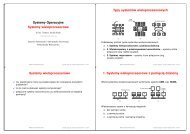Subsidize-free cost allocation method for infrastructure ... - Ozyrys
Subsidize-free cost allocation method for infrastructure ... - Ozyrys
Subsidize-free cost allocation method for infrastructure ... - Ozyrys
Create successful ePaper yourself
Turn your PDF publications into a flip-book with our unique Google optimized e-Paper software.
subject to<br />
∑<br />
i∈S<br />
x i ≥ C(I) − C(I \ S) ∀S ⊆ I (15)<br />
x i ≥ 0 ∀i ∈ I (16)<br />
For <strong>for</strong>mulas simplication, further we will use<br />
trans<strong>for</strong>med objective max(−x 1 , −x 2 , . . . , −x n ) =<br />
min(x 1 , x 2 , . . . , x n ) and variables ¯x = −x =<br />
(−x 1 , −x 2 , . . . , −x n ) = (¯x 1 , ¯x 2 , . . . , ¯x n ). Solution of<br />
minimization function (14) over simplex <strong>for</strong>med by set<br />
of incremental <strong>cost</strong> test inequalities usually is not unique.<br />
Simple scalarizing function, e.g. minimization of mean or<br />
maximum <strong>allocation</strong>, can result with an <strong>allocation</strong> easy to<br />
question from the point of view of general acknowledged<br />
<strong>allocation</strong> fairness. Particulary, two players with the same<br />
impact on the global <strong>cost</strong>s may be charged different<br />
values which minimize scalarizing function. If optimal<br />
solution equally treating both of the players exists, it<br />
should be strictly preferred. This lead to equitable rational<br />
preference relation concept based on equitable Pigou-Dalton<br />
shifts axiom. Equitable shift consists in worsening better<br />
(lower) <strong>allocation</strong> ¯x i and simultaneously decreasing higher<br />
<strong>allocation</strong> ¯x j by relatively small value ε > 0. Allocation<br />
vector ¯x − εe i + εe j arising from equitable shift is strictly<br />
preferred then original vector ¯x. Allocation vector ¯x ′<br />
equitable dominates vector ¯x ′′ if it is strictly preferred<br />
according to the rational equitable preference relation<br />
¯x ′ ≻ w ¯x ′′ .<br />
Let Θ : R n → R n denotes an operator of non-decreasing<br />
ordering the coordinates of vector ¯x, it means that Θ(¯x) =<br />
(Θ 1 (¯x), Θ 1 (¯x), . . . , Θ n (¯x)), where Θ 1 (¯x) ≤ Θ 2 (¯x) ≤ · · · ≤<br />
Θ n (¯x). Let ¯Θ = ( ¯Θ 1 , ¯Θ 2 , . . . , ¯Θ n ) be an operator of cumulative<br />
ordering, where ¯Θ i = ∑ i<br />
l=1 Θ l(¯x) <strong>for</strong> i = 1, 2, . . . , n.<br />
Successive coordinates of vector ¯Θ(¯x) signify the highest<br />
allocated value, sum of two highest allocated values, sum of<br />
three highest allocated values and so on. Then admissible<br />
solution x of task (14)-(16) is equitable effective if and only<br />
if it is solution of the following multi-criteria problem [7]:<br />
max{ ¯Θ(¯x)} (17)<br />
subject to constraints (15), (16) and ¯x = −x. This problem<br />
can be solved by trans<strong>for</strong>ming it into single criteria problem<br />
by weighing the criteria. This approach is equivalent to OWA<br />
aggregation (Ordered Weighted Average) applied to task of<br />
Θ(x) maximization subject to (15) and (16) [15]. OWA aggregation<br />
can be depicted in computational convenient <strong>for</strong>m<br />
of maximization linear combination of cumulative ordered<br />
criteria which can be expressed by linear <strong>for</strong>mulas. Finally,<br />
the following linear programme can be <strong>for</strong>mulated:<br />
MASIT OWA problem:<br />
max<br />
n∑<br />
w k (kv k −<br />
k=1<br />
n∑<br />
i=1<br />
d ki ) (18)<br />
∑<br />
i∈S<br />
x i ≥ C(I) − C(I \ S) ∀S ⊆ I (19)<br />
v k + x i ≤ d ki ∀i, k ∈ I (20)<br />
d ki , x i ≥ 0 ∀i, k ∈ I (21)<br />
where w k are nonnegative coefcients, v k are unlimited<br />
variables and d ki are nonnegative variables which represent<br />
bottom deviation <strong>for</strong>m v k .<br />
Notice, that in the consequence of equitable rational preference<br />
relation properties any solution of (18)-(21) satises<br />
<strong>allocation</strong> symmetry (anonymous) condition. Thus, the <strong>allocation</strong><br />
is not sensitive <strong>for</strong> players (constraints) renumbering.<br />
Constraints (19) result in incremental <strong>cost</strong> test satisfaction.<br />
Also property of positive <strong>cost</strong> <strong>allocation</strong> on inuential player<br />
and no <strong>cost</strong> <strong>allocation</strong> on insignicant player (dummy player)<br />
are satised. There<strong>for</strong>e, according to the condition (7), a<br />
solution of problem (18)-(21) is an <strong>allocation</strong> <strong>free</strong> from<br />
subsidizing.<br />
IV. ILLUSTRATIVE EXAMPLE<br />
We consider simple example of single commodity turnover<br />
among four sellers and one buyer. Offer data are presented<br />
in table I. Decisions related to the market game result<br />
from solving model OPT (1)-(5), where constraints (3) are<br />
following:<br />
−p 1 ≥ −50 (22)<br />
p 3 ≥ 100 (23)<br />
p 4 ≥ 50 (24)<br />
p 1 + p 3 ≥ 140 (25)<br />
If constraints (22)-(25) are relaxed, the economical benets<br />
are equal 13 thousands. When resource constraints are<br />
considered, benets fall to 9 thousands. Thus, the joint<br />
<strong>infrastructure</strong> <strong>cost</strong> of resource constraints is 4 thousands.<br />
An <strong>allocation</strong> according to the Shapley value is (1; 1.066;<br />
1.8; 0.133)∗10 3 respectively to the successive constraints<br />
(22)-(25). Let us notice, that relaxing third constraint causes<br />
economical benets increase by 2 thousands, while charge<br />
<strong>for</strong> this constraint is only 1.8 thousand. Incentives <strong>for</strong> this<br />
constraint intensication appear, if positive part of difference<br />
0.2 thousand can be directly or indirectly (as result of collusion)<br />
intercepted by player responsible <strong>for</strong> this constraint.<br />
Notice also, that there are many <strong>allocation</strong> vectors which<br />
are equitable effective solutions of multi-criteria task MASIT,<br />
e.g. <strong>allocation</strong>s (1; 1.2; 2; 0.8), (1.2; 1; 2; 0.8), (1.1; 1.1; 2;<br />
0.8). Because rst and second constraints of (22)-(25) are<br />
redundant, ona may expect that their <strong>cost</strong>s will not differ<br />
signicantly between them. There<strong>for</strong>e, an <strong>allocation</strong> (1.1;<br />
1.1; 2; 0.8) is preferred to the rest two <strong>allocation</strong>s. This<br />
<strong>allocation</strong> is also a solution of problem MASIT OWA (18)-<br />
(21) and is symmetric equitable solution <strong>for</strong> any values of<br />
w k .<br />
V. CONCLUSIONS<br />
In various practical problems, including <strong>infrastructure</strong> <strong>cost</strong><br />
<strong>allocation</strong> in the competitive market conditions, there is


